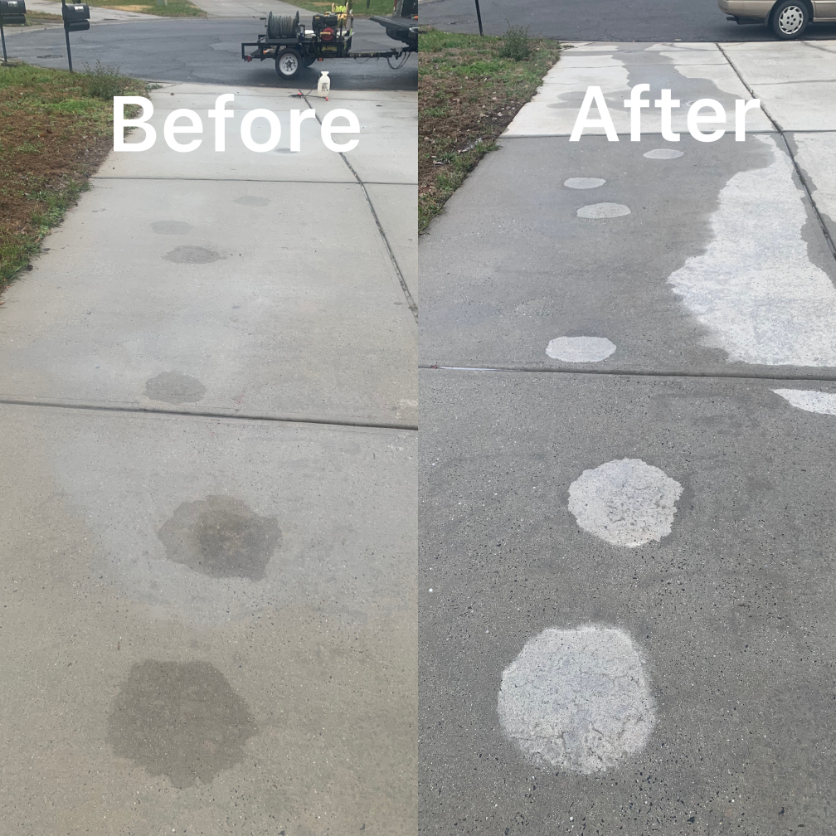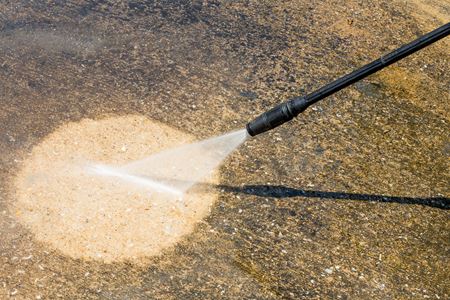Affordable Strongsville Fleet Washing Services to Maintain a Pristine Fleet
Affordable Strongsville Fleet Washing Services to Maintain a Pristine Fleet
Blog Article
Discover the most effective Methods for Oil Stain Removal From Concrete Surfaces
The existence of oil discolorations on concrete surface areas not only decreases aesthetic allure yet can also position obstacles for upkeep and security. Various techniques exist for effective elimination, varying from environment-friendly natural remedies to powerful commercial items, each fit to different severity degrees of spots - Oil Stain Removal in Strongsville. Understanding the ideal approach is crucial, as inappropriate methods may aggravate the issue. As we explore these approaches and their efficiency, it comes to be apparent that a strategic process is crucial for optimum results and lasting avoidance of future stains. What particular methods might yield the most success in your scenario?
Recognizing Oil Stains
Oil spots on concrete can be a relentless challenge for house owners and building managers alike. Understanding the nature of these spots is crucial for efficient elimination. Oil, whether from lorries, machinery, or other sources, leaks into the porous surface of concrete, producing deep-set staining that can be tough and undesirable to get rid of.
These stains vary in severity based on various elements, including the sort of oil, period of exposure, and specific concrete composition. Light oil spills might cause a superficial discolor, while much heavier oils can permeate a lot more deeply, making them a lot more difficult to tidy. Furthermore, ecological conditions such as temperature and humidity can impact exactly how oil communicates with concrete, influencing the stain's persistence.
Recognizing the characteristics of oil stains is important for selecting the ideal cleansing approach. For instance, lighter oils might respond well to absorbent materials, while larger oils usually call for much more aggressive cleaning solutions. Understanding these differences allows building proprietors to tailor their cleansing technique efficiently, ensuring that the picked technique aligns with the details sort of oil and discolor severity. This expertise eventually enhances the opportunities of successful oil tarnish removal from concrete surface areas.

Natural Cleaning Solutions
When resolving oil stains on concrete, numerous house owners look for eco-friendly options to conventional cleansing methods. All-natural cleaning remedies can be highly effective for taking on these stubborn discolorations while decreasing environmental influence.
One popular method involves making use of cooking soda, a functional and non-toxic compound. Spraying baking soda over the oil tarnish and allowing it to rest for a number of hours will aid take in the oil. Afterward, scrub the area with a rigid brush and wash it with water.

Additionally, cat trash can work as an absorptive product, specifically if the tarnish is fresh. Spreading out pet cat clutter over the stain and allowing it to sit overnight can help draw out the oil.
These all-natural approaches not just give reliable oil tarnish elimination however also advertise a healthier atmosphere, making them ideal selections for diligent house owners.
Commercial Products Introduction
While all-natural cleansing solutions can properly address oil stains, several house owners might prefer the convenience and potency of business items particularly developed for this purpose. These items are created to damage and penetrate concrete surfaces down oil discolorations extra effectively than conventional methods.
Business oil discolor removers commonly consist of powerful solvents and cleansing agents that target the oil at a molecular level. They usually can be found in different kinds, consisting of powders, gels, and fluids, allowing customers to choose an item that finest fits their specific demands. Some formulations are made for durable discolorations, while others are appropriate for regular maintenance.
Along with conventional solvents, several business items include biodegradable parts, making them much more eco friendly options. Customers ought to guarantee they select a product that is compatible with their certain concrete surface area and follow maker instructions for ideal outcomes.
Before applying any kind of commercial cleaner, it is recommended to perform a place test in a very discreet location to stop prospective staining. Inevitably, the right industrial item can significantly simplify the oil discolor elimination procedure, providing effective options for keeping the look of concrete surface areas.
Step-by-Step Removal Process
To efficiently eliminate oil discolorations from concrete, adhere to an organized detailed process that guarantees complete cleansing and reconstruction - Oil Stain Removal in Strongsville. Begin by collecting necessary materials, including absorbent pads, a stiff-bristle brush, a degreasing agent, and a stress washing machine if readily available
Beginning by using an absorbing find this product, such as pet cat clutter or baking soft drink, straight onto the oil discolor. Enable it to sit for at the very least half an hour to absorb the oil. Afterward, sweep away the absorbent product and throw away it effectively.
Following, use an industrial degreaser or a mix of meal soap and warm water to the stained location. Allow the remedy rest for 10-15 mins to permeate the discolor. Scrub the location strongly with a stiff-bristle brush, making sure to work the solution right into the concrete's pores.
Wash the area thoroughly with water, ideally making use of a stress washer for better outcomes. Examine the stain; if residues linger, repeat the degreasing process. Ultimately, enable the concrete to dry completely prior to thinking about any safety procedures or sealants to stop future discolorations.
Avoiding Future Stains
Protecting against future oil spots on concrete calls for proactive actions that address prospective resources of contamination. One effective method is to maintain a clean setting by routinely examining and maintaining vehicles, machinery, and devices to prevent leaks and spills. Applying a routine check for oil leaks can dramatically reduce the danger of unexpected stains.

Securing the concrete surface area with a high-quality sealant is one more precautionary procedure that boosts resistance to discoloration - Oil Stain Removal in Strongsville. A sealer develops a safety layer that can protect against oil from passing through the concrete, making it less complicated to cleanse up spills
Finally, informing all individuals of the space concerning correct treatments for taking care of oil and lubricating substances can cultivate a society of obligation. By carrying out these methods, residential property proprietors can successfully reduce the risk of future oil stains, maintaining the honesty and look of their concrete surfaces.
Final Thought
To conclude, effective oil tarnish elimination from concrete surfaces necessitates a thorough understanding of the tarnish's nature and ideal cleaning methods. Both commercial and all-natural options provide practical alternatives for attending to varying levels of oil spots. Executing an site link organized elimination process, adhered to by safety nets, adds to the longevity and honesty of concrete surfaces. Inevitably, a positive approach to upkeep will certainly decrease the incident of future discolorations and protect the functional and aesthetic top qualities of concrete.
The presence of oil discolorations on concrete surface areas not only lessens aesthetic charm yet can also position obstacles for maintenance and security. Spraying cooking soft drink over the oil discolor and permitting it to sit for several hours will certainly aid soak up the oil.Commercial oil discolor cleaners typically include effective solvents and cleansing agents that target the oil at a molecular level.Protecting against future oil stains on concrete requires aggressive measures that deal with prospective resources of contamination.In verdict, reliable oil tarnish elimination from concrete surfaces necessitates an extensive understanding of the discolor's nature and proper cleansing approaches.
Report this page